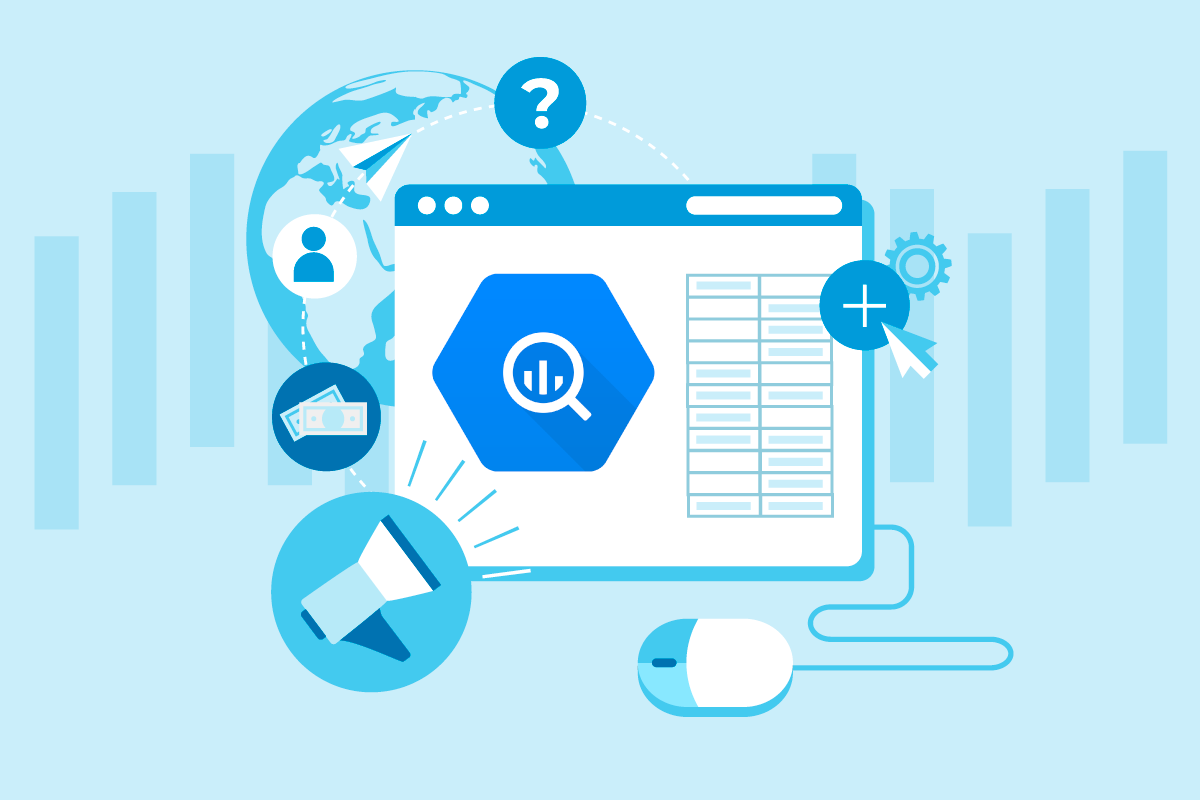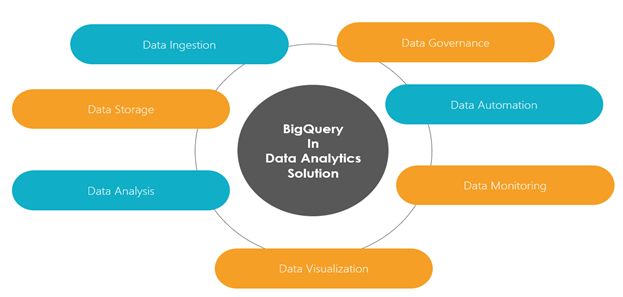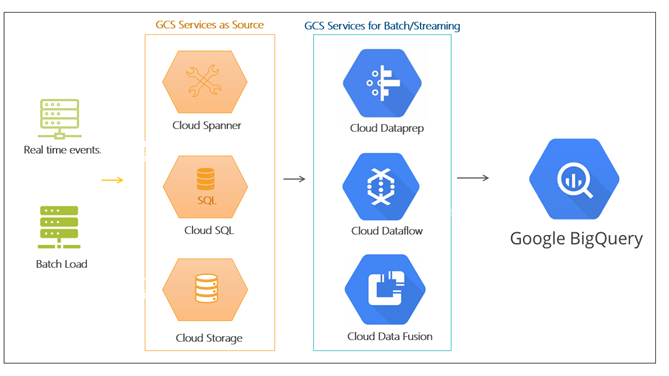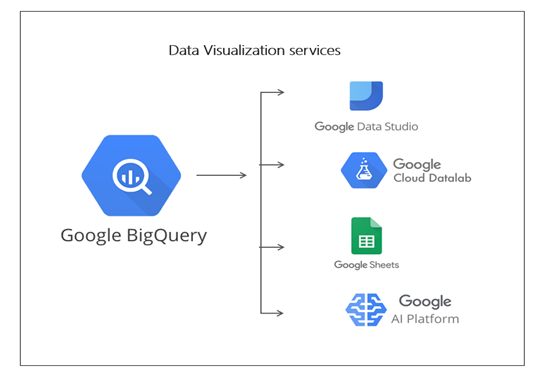Introduction
Data analytics solutions collect, process, and analyze data to extract insights and make informed business decisions. The need for a data analytics solution arises from the increasing amount of data organizations generate and the need to extract value from that data. Data analytics solutions can help organizations gain insights into their customers, operations, and performance, leading to improved decision-making, increased efficiency, and cost savings. Data analytics solutions can also identify new opportunities and support strategic planning.

Source: indaacademy.vn
Learning Objectives
This article discusses integrating BigQuery with other GCP services for a complete Data Analytic Solution. By integrating it with other GCP services, you can create a comprehensive data analytics solution that enables you to collect, store, analyze, and visualize large datasets, making it easier to gain insights and make data-driven decisions.
This article was published as a part of the Data Science Blogathon.
Table of Content
- Different Stages of the Data Analytics Solution Cycle
- Integrating BigQuery with Data Ingestion
- Integrating BigQuery with Data Storage
- Integrating BigQuery with Data Analysis
- Integrating BigQuery with Data Visualization
- Integrating BigQuery with Data Governance
- Integrating BigQuery with Data Automation
- Integrating BigQuery with Data Monitoring
- Conclusion
Different Stages of the Data Analytics Solution Cycle
The processes in which BigQuery can be used to provide a better Data Analytic Solution are as follows:
- Data Ingestion
- Data Storage
- Data Analysis
- Data Visualization
- Data Governance
- Data Automation
- Data Monitoring

Integrating BigQuery With Data Ingestion

Integrating BigQuery with Data Storage
- Setting up a Google Cloud Storage (GCS) Bucket to Store Data: GCS is a highly scalable and durable object storage service that can store and serve data.
- Integrating GCS with BigQuery: You can load data directly into BigQuery from GCS using the web UI, command-line tools, or its API.
- Loading Data from Other GCP Services: You can use Cloud SQL, Cloud Pub/Sub, or Cloud Datastore to store data and then load it into BigQuery for analysis.
- Setting up Data Transfer Schedules: You can use Cloud Scheduler to schedule data transfers from other GCP services regularly.
- Monitoring and Auditing your Data Transfers: You can use Cloud Logging and Stackdriver to monitor your data transfers and ensure they run smoothly.
By integrating GCP services with BigQuery, you can take advantage of the scalability, durability, and security of GCP to store and analyze large amounts of data.
Integrating BigQuery with Data Analysis
Data analysis in GCP refers to using various GCP tools and services to extract insights and knowledge from data stored in GCP. This can include using BigQuery for data warehousing and SQL-based analysis, Dataflow for ETL and data processing, and machine learning tools such as TensorFlow and AutoML for predictive modeling and analysis. Additionally, GCP offers a variety of visualization and reporting tools, such as Google Data Studio, to help users understand and communicate their findings. We can use BigQuery with other GCP services such as Cloud AI Platform, Cloud Machine Learning Engine, or Cloud Dataproc to analyze and model your data.
The goal of data analysis in GCP is to turn raw data into actionable insights that can inform business decisions and drive strategic direction.
Integrating BigQuery for Data Visualization
Data visualization in BigQuery refers to creating visual representations of data stored in BigQuery, such as charts, graphs, and maps. This can be done using various tools, such as Google Data Studio, Tableau, and Looker, which allow users to connect to their BigQuery data and create interactive visualizations. Visualizing data in BigQuery can help users quickly identify trends, patterns, and insights in their data and make more informed decisions. Additionally, data visualization tools can enable users to share their data and insights with others in an easy-to-understand format.
Integrating Google Cloud Platform (GCP) services for data visualization can be achieved in several ways. Here are some steps you can follow:
- Prepare your Data: Ensure your data is in a format that can be easily queried and visualized, such as a table with columns and rows.
- Use Google Data Studio: It is a free data visualization tool that can be used to create interactive dashboards and reports from your BigQuery data. To use Data Studio, you need to connect it to your BigQuery dataset by creating a Data Source.
- Use Google Sheets: It is a spreadsheet tool that can be used to create charts, pivot tables, and graphs from your BigQuery data. To use Sheets, you need to connect it to your dataset by creating a Data Connector.
- Use Google Cloud Datalab: It is a cloud-based data exploration, analysis, and visualization tool. To use Datalab, you need to create a new Datalab instance, connect it to your dataset, then use the built-in Jupyter notebooks to perform analysis and visualization.
- Use Google Cloud AI Platform: It is a cloud-based platform for developing and deploying machine learning models. To use AI Platform, you can use the BigQuery ML feature to create and deploy machine learning models directly and then use AI Platform for data visualization.

Integrating BigQuery with Data Governance
Data governance in BigQuery refers to the policies, procedures, and standards organizations implement to ensure that their data is accurate, consistent, and compliant with regulatory requirements. This includes data quality checks, encryption, lineage tracking, and access controls. By implementing a robust data governance strategy in BigQuery, organizations can ensure that their data is reliable and secure and that they can make informed business decisions based on that data.
Integrating BigQuery with Data Automation
Data automation in BigQuery refers to using automated processes to manage data flow through the analytics pipeline, from ingestion to visualization. This can include scheduling regular data imports, automatically cleaning and transforming data, and creating and updating visualizations based on the latest data. Automation can ensure data is consistently and accurately processed, reducing the need for manual intervention and freeing up time for more complex analysis and decision-making.
Integrating BigQuery with Data Monitoring
Data monitoring in GCS (Google Cloud Storage) involves monitoring GCS’s performance, usage, and security. This can include monitoring storage usage and costs, tracking data access and permissions, and monitoring data integrity and consistency. Monitoring can also include tracking events such as data uploads, deletions, and changes and identifying and addressing any data-related issues or anomalies.
Conclusion
In conclusion, integrating BigQuery with other GCP services such as Cloud Storage, Dataflow, and Dataproc can provide a complete data analytics solution for organizations. It provides fast and scalable data storage and querying capabilities. In contrast, GCP services such as Google Data Studio, Google Sheets, Google Cloud Datalab, and Google Cloud AI Platform provide various data visualization and analysis tools. This integration enables organizations to easily access and analyze large datasets, create interactive reports and dashboards, and perform advanced analytics tasks like machine learning. By combining these services, organizations can gain insights into their data and make informed decisions. It is important to choose the right tools and services based on each project’s specific needs and requirements, to get the most value out of the integration. The key takeaways from this article are as follows:
- By integrating GCP services with BigQuery, you can take advantage of the scalability, durability, and security of GCP to store and analyze large amounts of data.
- Utilizing services such as Dataflow and Dataproc for data processing and analysis can further enhance the capabilities of the data analytics solution.
- Data governance and security are crucial considerations when setting up a data lake on GCP using BigQuery and Cloud Storage.
- By leveraging its power for data warehousing and SQL-based querying, along with the scalability and flexibility of Cloud Storage for data ingestion and storage, organizations can gain insights and drive business value from their data.
The media shown in this article is not owned by Analytics Vidhya and is used at the Author’s discretion.






